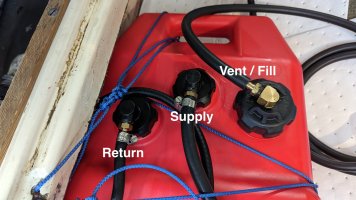peaman
Sustaining Member
I need to remove my fuel tank to check on a possible fuel leak into the bilge. I know of at least three members here who have been there, done that, so I know it is generally do-able. I thought that if I could disconnect the fill and vent lines at the aft end of the tank, I should be able to shift the tank aft and outboard to get out from under the quarter berth construction, but there are two issues with that: 1) the length of 1-1/2" fill hose is too short, and the nipple too long, to be able to disconnect it without cutting it, and 2) the fuel hoses, battery cables and significant other wiring passing over the fuel tank and into the engine compartment greatly restrict any movement at the forward end.
So my questions are:
a) how can the very stubborn fuel fill hose be disconnected from the rear of the tank prior to moving the tank?
b) If I need to remove wiring at the forward inboard corner of the tank in order to remove the tank, are there suggestions for improving the wiring routing when the wiring is put back into place?
I did see this thread with some great pictures and commentary from Tin Kicker, Kenneth K, and nquigley, so thanks for that good info.
So my questions are:
a) how can the very stubborn fuel fill hose be disconnected from the rear of the tank prior to moving the tank?
b) If I need to remove wiring at the forward inboard corner of the tank in order to remove the tank, are there suggestions for improving the wiring routing when the wiring is put back into place?
I did see this thread with some great pictures and commentary from Tin Kicker, Kenneth K, and nquigley, so thanks for that good info.













